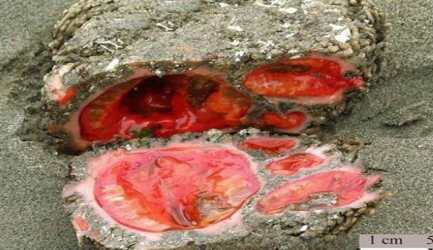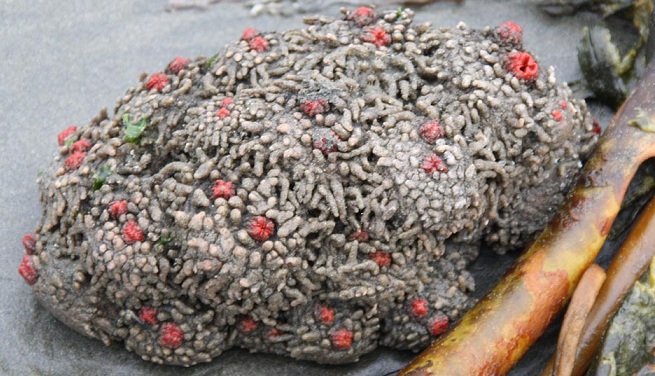The Ancestors of Us All
By Jeremy Zolan
If you’re friends with scientists, nature lovers, or enthusiasts of everything strange, you may have seen the article Crazy living rock is one of the weirdest creatures we’ve ever seen by Grist making rounds on social media lately. Prominently featured at the top of the article is a picture of said creature, which is actually an ascidian called Pyura chilensis- piure if you speak Spanish, a member of a subphylum called the tunicates. Diverse in color and morphology, these primitive inhabitants of oceans worldwide aren’t part rock, but actually are very close relatives of vertebrates due to their peculiar nervous system. Although they are technically invertebtrates because they have no bones or cartilage, they possess a very primitive spinal cord called a notochord that renders them closer relatives to fish. In the larval stage, most tunicates look like microscopic fish or tadpoles and freely swim until they find substrate to attach themselves. When they do, they change shape into a sessile form with siphons similar to those of clams to feed on plankton in the water column. The tail of the larval tunicate shrinks, the notochord dissolves, and the body becomes enlarged. Some species such as the piure live in colonies of many individuals and some are invasive and have outcompeted native benthic fauna, especially those found in the Mid-Atlantic and New England region.

Typical cluster of Pyura clustered together, creating a meaty looking rock.

Pyura Chilensis being served as food
Equally as peculiar is the mysteriously high concentration of vanadium found in the tunicates. Vanadium is an unusual but not uncommon metal that exists in many brightly colored oxidation states. Usually, vanadium as the vanadyl cation (vanadium in its 4+ oxidation state double bonded to oxygen) is only necessary as a minor trace element in biology. Tunicates however have up to ten million times the amount of vanadium in their bodies that other living things do. They use it in the form of a vanabin- a vanadyl-protein complex possibly employed for oxygen transport. This is somewhat of a mystery; there is no scientific basis for this because tunicates another oxygen binding metalloprotein as well- hemocyanin, a blue copper containing complex found in many kinds of marine life. It is thought that this molecule could handle all of a tunicate’s needs for oxygen transport. Much research is being done in this field so we may know the answer.
Tunicates are also edible and while you may be unappetized by something that looks like the Horta from Star Trek, many Chileans, Japanese, and Koreans call them dinner. In Korea, they are typically eaten raw as hoe (raw seafood) with seasonings like soy sauce and chogochujang, a spicy chili paste. Koreans do use them in soups, stews and other dishes like bibimbap. In Chile, the rocklike piure are eaten raw with lime or in a soup which is a bit like a Chileno bouillabaisse. Tunicates are quite common on the seashore and though they may look extremely terrifying, in this day of farm to table eating and waste-not want-not ethos surrounding food, why get all squeamish over trying a bit of alien looking seafood?

Pyura Chilensis cluster
References:
Michibata H, Uyama T, Ueki T, Kanamori K (2002). Vanadocytes, cells hold the key to resolving the highly selective accumulation and reduction of vanadium in ascidians. Microscopy Research and Technique. Volume 56 Issue 6, Pages 421 – 434
Tatsuya Ueki et al (2003). Vanadium-binding proteins (Vanabins) from a vanadium-rich ascidian
Ascidia sydneiensis samea
http://ir.lib.hiroshima-u.ac.jp/metadb/up/74006214/BBA_1626_43-50_2003.pdf